Medium Format Lenses with
the Pentacon Six Mount
A comparative test
by TRA
Further 1000mm lens tests
Part 4
The Test Results, conclusion:
The three 500mm-600mm mirror
lenses with a 2× converter
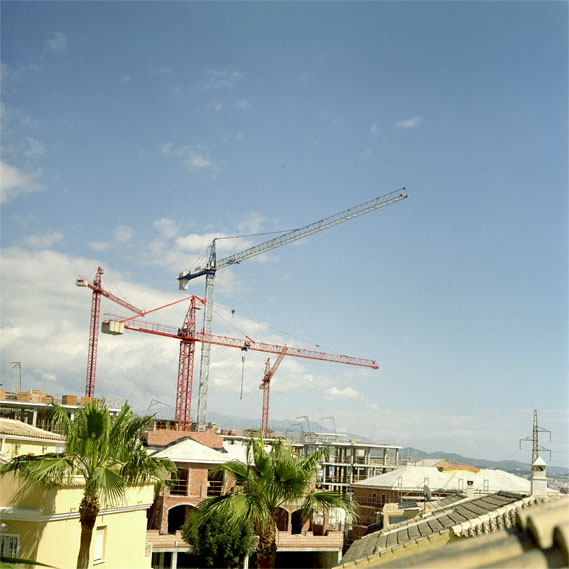
[C427-7] View chosen for the 500mm – 1000mm tests
A reminder of the coverage given with the 80mm standard lens.
Compare it with the area covered below at 1000-1200mm!
1980s Biometar f/2.8 80mm at f/9.5 1/500
Fuji NPC 160
Mirror lenses & 2×
Converters
It is unfortunately not possible to use the Schneider-Kreuznach converter
with the three mirror lenses, as the front element of the converter protrudes
forward of the converter mount into the back of the lens used with it,
and there is not space for this at the back of the Rubinars and the 3M-3B.
For this reason, with these three lenses the next-best 2× converter
was used: the one from Arsenal in Kiev.
Rubinar f/5.6 500mm mirror
lens with Arsenal 2× converter
The first thing to say is that with this combination the subject is
magnified much more than when the 1000mm mirror lens is used. In
other words, this confirms the conclusion in the 500mm-600mm test that
this “500mm” mirror lens is in fact nearer to 600mm. That was the
“good news”, assuming that “the longer, the better”. Now to the “bad
news”.
Coverage
To avoid any possibility of the lens hood (“shade”) being blamed for
vignetting, this lens was tested with and without the hood. Of course,
with a 2× converter in place, only the middle area of the image is
being used anyway, so even if the hood were to be blamed for the vignetting
when the lens is used on its own, it couldn’t be the cause of any vignetting
how. But anyway, we can see if the hood improves contrast.
The central “hot spot” reported here
is still visible, although now of course it occupies a much larger portion
of the image, reaching nearly – but not quite! – to the centre point of
each of the four edges. Put another way, a larger area of the image
has reasonably even illumination, before the vignetting cuts in.
This is to be expected, as we are only using the middle area of the image
produced by the lens. After the vignetting, which is obvious but
may not be disastrous in all situations, come the deep shadows in the corners,
particularly at the top, which we recognise from when we used the Arsenal
2× converter with the Arsat APO 500mm lens.
Rubinar f/5.6 500mm mirror lens with Arsenal 2× converter
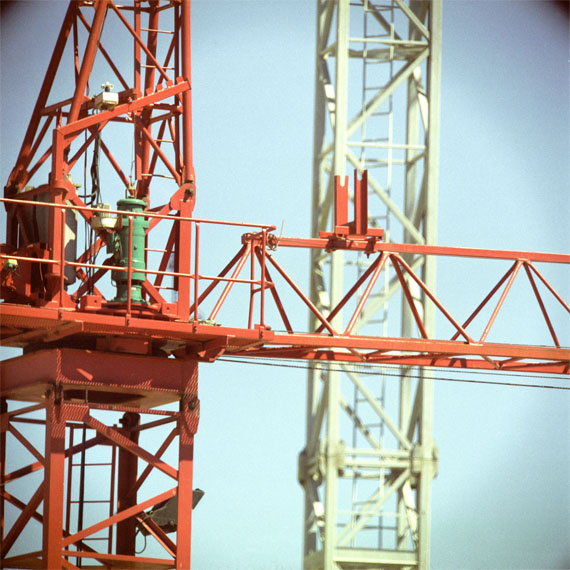
[C430-4]
“500”mm f/5.6 Rubinar with Arsenal 2× converter 1/250
(effective f/11)
No shade
|
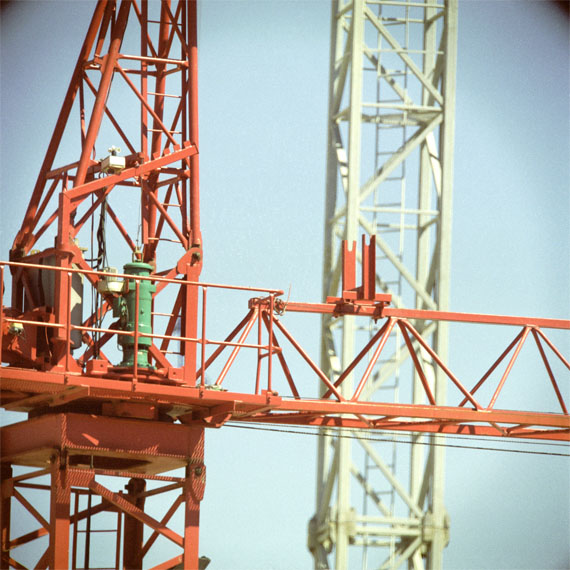
[C430-5/6]
“500”mm f/5.6 Rubinar with Arsenal 2× converter 1/250
(effective f/11)
With shade
|
Fuji NPC160
Lens hoods, or shades, can be crucial in improving contrast when there
is a danger that the main light source might fall on the front surface
of the lens, but with the sun here well away to one side and high above
us, no difference is really obvious in these two shots in consequence of
using the shade.
Resolution
The resolution with this combination is very good on the in-focus parts
of the image. It does not of course match the resolution achieved
with the Pentacon or Arsat APO 500mm lenses when stopped down to f/11 and
used in combination with the Joseph Schneider 2× converter, or even
the resolution of the APO lens at f/11 with the Arsenal 2× converter,
but it is very similar to what is obtained at f/5.6 with those lenses and
a converter. The “with shade” shot is another negative that suffers
from fingerprints from the processing lab. I have endeavoured to
clone these out, but with only partial success. As indicated in the
500-600mm review, I wrote to the lab. Their response was unsatisfactory,
and so I have changed lab. The new processor has so far developed
films and produced prints without any of these problems.
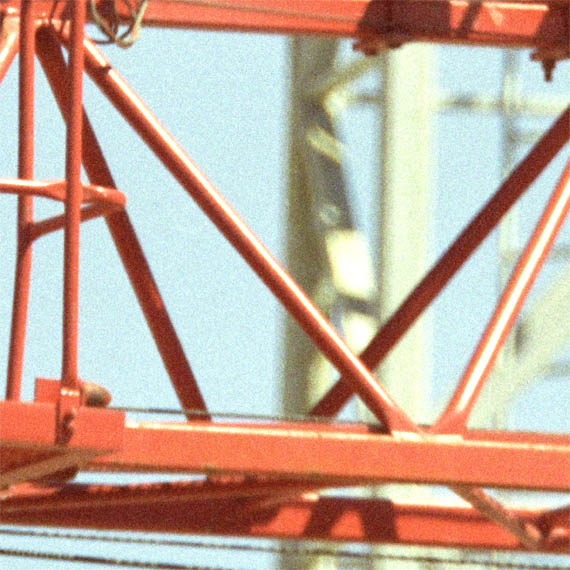
[C430-4r]
“500”mm f/5.6 Rubinar with Arsenal 2× converter 1/250
(effective f/11)
No shade
|
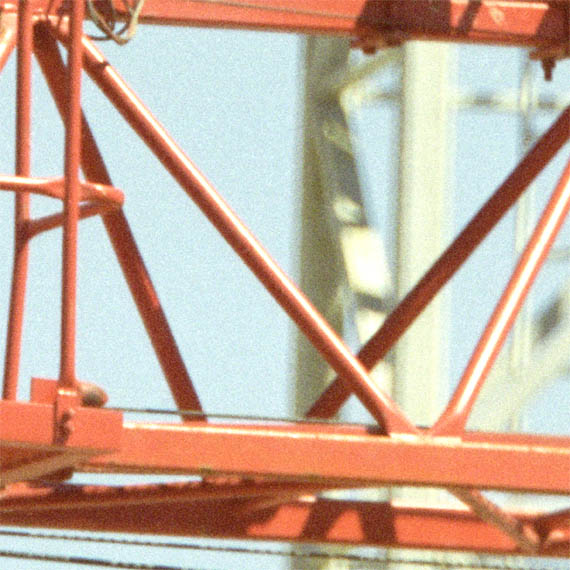
[C430-5/6r]
“500”mm f/5.6 Rubinar with Arsenal 2× converter 1/250
(effective f/11)
With shade
|
Fuji NPC160
Colour Fringeing
We saw with the 500-600mm tests that mirror lenses do not give rise
to colour fringeing. Of course, here we have a mirror lens image
magnified 2× by a refrective lens – the Arsenal 2× converter
that gave us massive chromatic aberrations when used in conjuction with
the Arsat 500mm APO lens. When these images are magnified enormously,
a tiny amount of chromatic aberration or colour fringeing is just
visible as one approaches the corners of the image. At normal degrees
of enlargement it would not be visible at all.
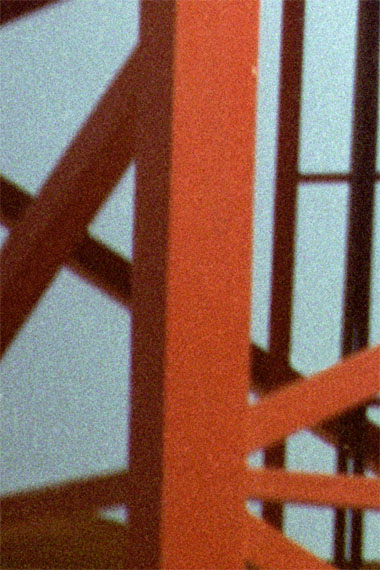
[C430-4cf]
“500”mm f/5.6 Rubinar with Arsenal 2× converter 1/250
(effective f/11)
No shade
From bottom left-hand corner
|
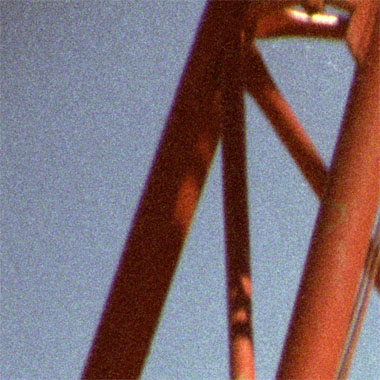
[C430-4cf2]
“500”mm f/5.6 Rubinar with Arsenal 2× converter 1/250
(effective f/11)
No shade
There is no image detail in the top right-hand corner with this shot,
so I have taken this detail from very near to the top left-hand corner.
Vignetting is clearly more of an issue than chromatic aberration here.
|
Fuji NPC160
Rubinar f/8 500mm mirror lens
with Arsenal 2× converter
The lighting with the tests of this lens is slightly different, and
so is the film: Fuji NPH 400 instead of the Fuji NPC 160 used with most
of the other tests. It was necessary to re-shoot the original test
for this combination, as the results were not sharp. This just re-emphasises
the principal difficulty when working with such long lenses: getting the
focus spot-on.
Coverage
Coverage is better than with the f/5.6 Rubinar, with slight image darkening
near the corners, plus the usual cut-off caused by the Arsenal 2×
converte much nearer to the corners. In prints or mounted slides
the cut-off caused by the converter is scarcely visible at the bottom of
the image, but it is clear at the top, especially at the top left-hand
corner.
Rubinar f/8 500mm mirror lens with Arsenal 2× converter
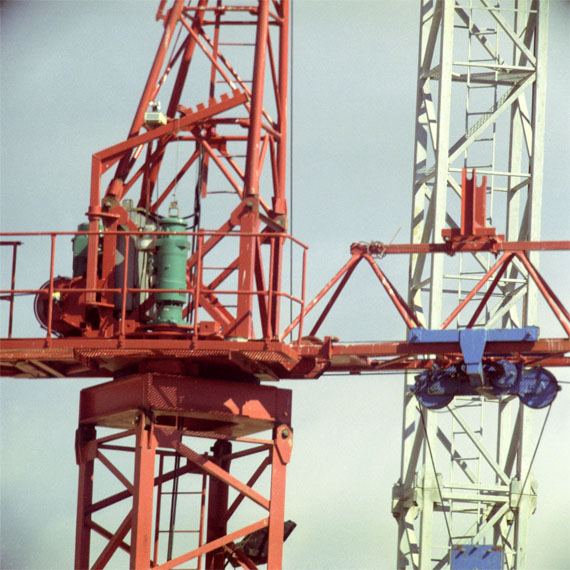
[C437-13]
“500”mm f/8 Rubinar with Arsenal 2× converter 1/250
(effective f/16)
No shade
|
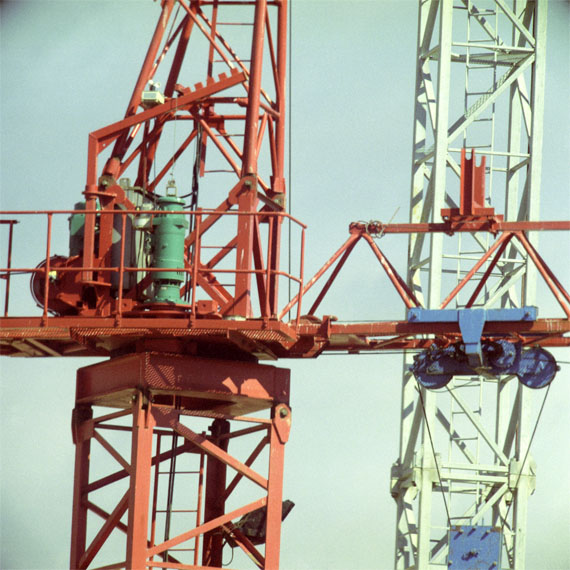
[C437-14/15]
“500”mm f/8 Rubinar with Arsenal 2× converter 1/250
(effective f/16)
With shade
|
On Fuji NPH 400 focussed a fraction after 50M
Resolution
Resolution is very good on the in-focus areas. With both images
it is clear that critical focus is on the rear crane.
As with the f/5.6 Rubinar, adding or removing the lens hood has not
made any difference to the images, with the direction of lighting prevailing
at the time. Naturally, there could be many other occasions when
using the lens hood would improve the image. It clearly is not the
cause of the vignetting that is observed.
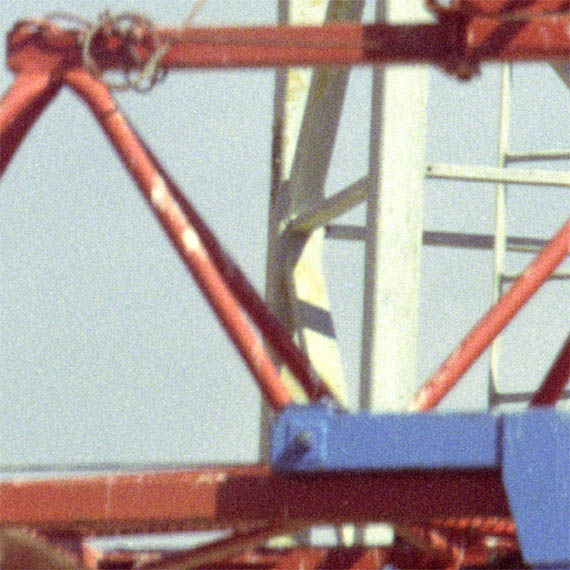
[C437-13r]
“500”mm f/8 Rubinar with Arsenal 2× converter 1/250
(effective f/16)
No shade
Critical focus is clearly on the rear crane – or somewhere between
the two!
|
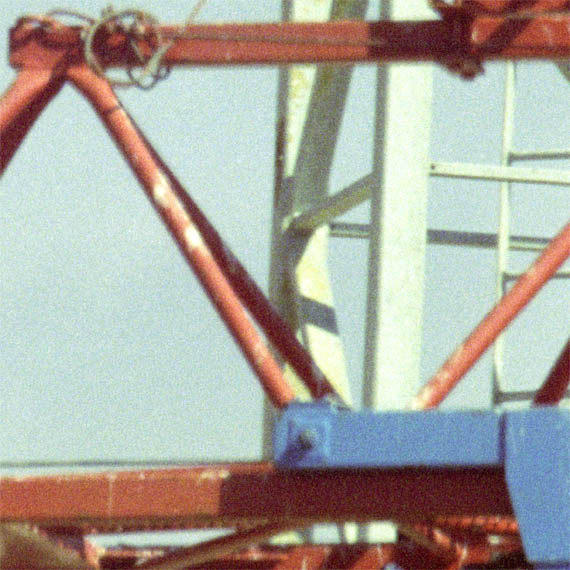
[C437-14/15r]
“500”mm f/8 Rubinar with Arsenal 2× converter 1/250
(effective f/16)
With shade
|
On Fuji NPH 400 focussed a fraction after 50M
Colour Fringeing
There is a negligible amount of colour fringeing at the very edges
of the frame. This is very good, while not quite up to the result
when the lens was used on its own.
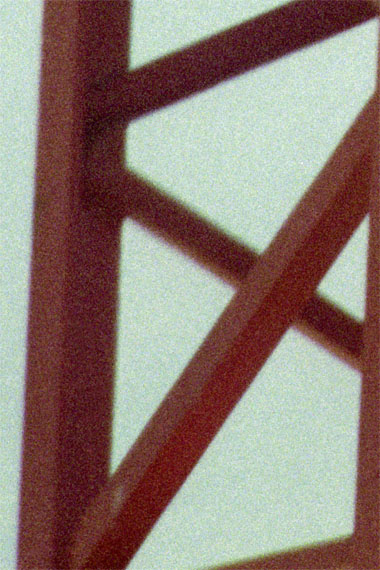
[C437-14-15cf]
“500”mm f/8 Rubinar with Arsenal 2× converter 1/250
(effective f/16)
With shade
From bottom of image, about 1/4 of the way in from the left.
At this degree of magnification, it is clear that the image is not
critically sharp on the front crane.
|
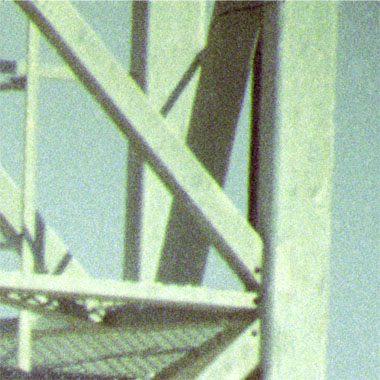
[C437-14-15cf2]
“500”mm f/8 Rubinar with Arsenal 2× converter 1/250
(effective f/16)
With shade
From very near to the top right-hand corner.
A tiny amount of faint green fringeing can be seen where the diagonal
beam in the sunlight crosses the beam behind it in the shadow.
This is not visible at normal degrees of enlargement.
|
On Fuji NPH 400 Focussed a fraction after 50M
Arsat 3M – 3B f/8 600mm mirror
lens with Arsenal 2× converter
For these tests, the Hasselblad compendium shade no. 40726 as described
here
was mounted on the lens. When this shot was taken, the top crane
had rotated slightly towards the taking position, as will be observed from
the picture, moving the front of the crane boom arm away from the plane
of sharpest focus.
Coverage
The tests of the 3M – 3B f/8 600mm mirror lens on its own showed even
illumination across the whole frame. As discovered in these new tests,
the Arsenal 2× converter has introduced severe vignetting when used
with other good lenses, and the current combination is no exception.
There is very marked darkening (almost to black!) of all four corners of
the image. At the bottom of the picture this does not extend very
far, and on standard prints or mounted slides is not particularly noticeable,
but the darkening of the top corners, especially the top-left, extends
considerably further into the image and is very obvious.
3M – 3B f/8 600mm mirror lens with Arsenal 2× converter
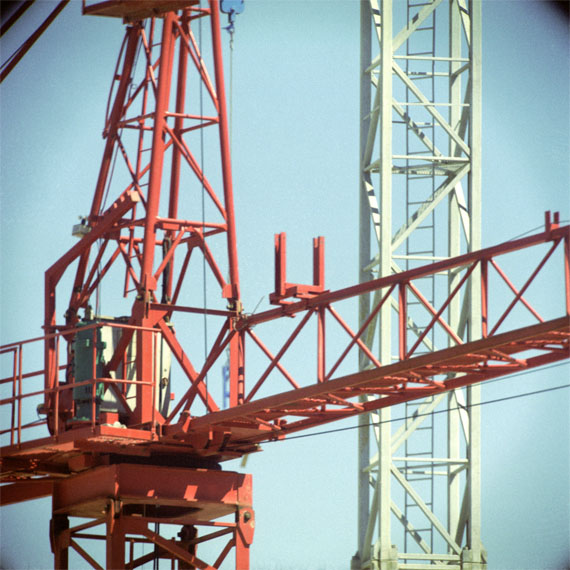
[C430-10] 3M – 3B f/8 600mm mirror lens with Arsenal 2× converter
(effective f/16) 1/125 with Hasselblad compendium shade fully extended
Fuji NPC 160
Resolution
Another frame from the batch of films that came back from the processing
lab with fingerprints, the scan of this negative has required careful re-touching,
especially in the sky areas. Success has been partial, but I have
been careful not to invalidate the test by more extensive re-touching.
Focus is not totally spot-on, but sharpness is excellent, restricted
principally by the extremely shallow depth of field.
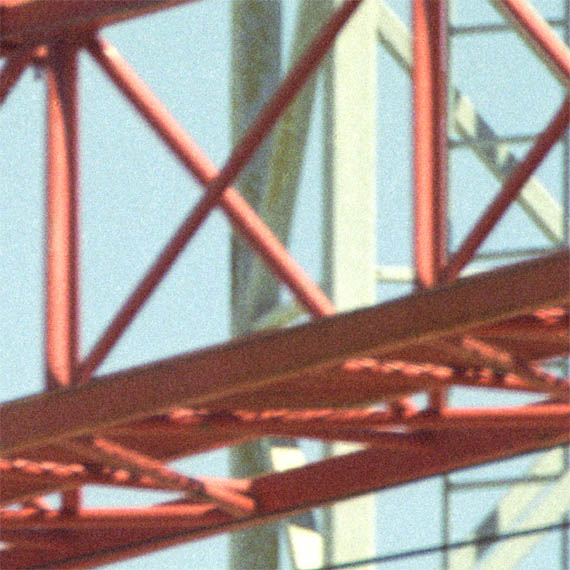
[C430-10r]
3M – 3B f/8 600mm mirror lens with Arsenal 2× converter
(effective f/16) 1/125 with Hasselblad compendium shade fully extended
Fuji NPC 160
Colour Fringeing
When using this lens on its own we discovered a total lack of chromatic
aberrations or colour fringeing, as is to be expected with mirror lenses.
When the Arsenal 2× converter is added, some colour fringeing appears
at the edges and especially approaching the corners of the image.
This confirms our experience when using this converter with other lenses,
above.
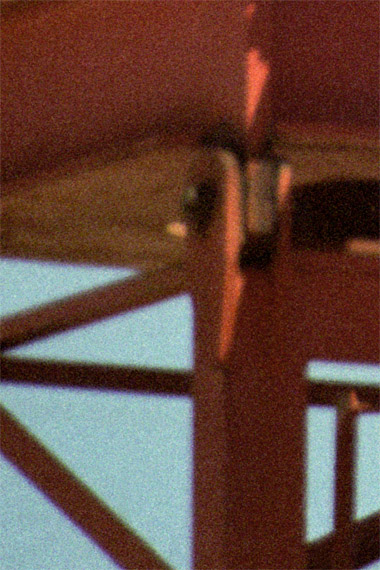
[C430-10cf]
3M – 3B f/8 600mm mirror lens with Arsenal 2× converter
(effective f/16) 1/125 with Hasselblad compendium shade fully extended
From the bottom of the image, less than a quarter in from the left-hand
corner. |
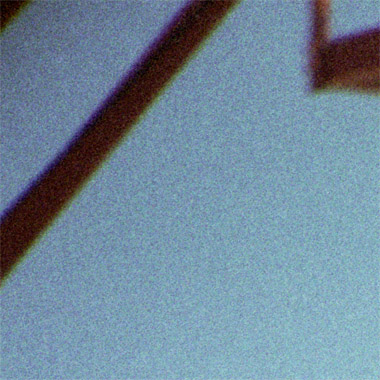
[C430-10cf2]
3M – 3B f/8 600mm mirror lens with Arsenal 2× converter
(effective f/16) 1/125 with Hasselblad compendium shade fully extended
From the top of the image, very close to the top left-hand corner.
The grain of this ultra-fine-grain film is again obvious in this massive
enlargement. A tiny amount of colour fringeing is noticeable, and
this must be due to the Arsenal 2× converter, which is also the cause
of the considerable vignetting that is obvious here. |
Fuji NPC 160
Conclusion
Judged by coverage alone, the worst results came from using the
Arsat APO lens with the Arsenal 2× converter. The best results
were from the same Arsat APO lens with the Schneider 2× converter.
The 1000mm Carl Zeiss Spiegelobjektiv is between these two extremes, not
far behind the APO/Schneider result.
Judged by image resolution, the sharpest image of the red crane
was obtained with the 1000mm Carl Zeiss Jena mirror lens on its own.
However, this is easily matched by the Arsat APO 500mm lens with the Schneider
2× converter and by the Pentacon 500mm lens with the Schneider 2×
converter, when the lens is stopped down to f/11. Crucial
to sharpness with these extreme focal lengths is critically accurate focus,
and it might be better to use the magnifier head on the camera, which magnifies
the prism image 4×, or the magnifying attachment (also known as the
“Focussing Telescope”) on the back of the metering prism. (See these
two accessories here and here.)
Looking at colour fringeing (or the lack of it), the 1000mm Carl
Zeiss Jena mirror lens is top. The other mirror lenses also show
an absence of colour fringeing when used on their own, but in the combination
used here, with the Arsenal 2× converter, some very minor colour
fringeing is introduced. The mirror lenses are followed closely by
the 500mm Pentacon and 500mm Arsat APO lenses, when used with the Schneider
Kreuznach 2× converter.
Unfortunately, coverage problems with the two Rubinars virtually eliminate
them from the running, in my opinion.
All lens designs are the result of a compromise: a balance between performance,
size, weight and cost. In many cases, the absolutely peak performance
would result in a lens that was too heavy to carry or too expensive for
most people to buy. Going for this option might be right for a scientific
astronomical observatory, but not for ordinary photographers – or even
most professionals. If you get the ultimate lens, but it is so heavy
that you rarely take it with you, it won’t be there for that rare and special
shot.
My personal conclusion is that the best way for me to achieve 1000mm
in most circumstances is with the Arsat APO 500mm lens used in combination
with the Schneider-Kreuznach 2× converter, combining high quality
with portability, with the additional benefit of increased depth of field
when stopping down to f/11 on the taking lens (equivalent to f/22 as regards
light reaching the film, when used with the converter) – an option
that is not available with mirror lenses. The Pentacon 500mm
lens with the same converter gives results that are virtually indistinguishable
from the above combination, but with a larger, heavier lens, and loss of
automatic aperture operation. The advantages, however, are that the
Pentacon lens is much more readily available, and is also a lot cheaper
than the rare Arsat APO lens.
As a source for the 500mm APO or the 600mm 3M – 3B mirror lens, I recommend
Zhanna in Kiev, who trades on eBay as “grizzly33bear” – though you may
have to wait for a while for an APO lens to turn up.
I am grateful to Dr Ray Butler for permission to quote from his summary,
having read this review. He says:
-
“The 1000mm f5.6 mirror lens’ performance is awesome considering
that it does it 2 stops faster than anything else in your test (all the
other combinations being at least f11 due to the converter, as you pointed
out). And while I know that results were subject to focusing accuracy,
I think that one has to look to the f22 (2× f11) pictures with the
other lenses to get the same sharpness and contrast as the 1000mm mirror
at f5.6 - that’s a 4-stop difference!
-
I would agree with the conclusion that the Schneider 2×
converter is excellent. It seems to take nothing away from the lens’ underlying
performance, which is all you can ask of a converter.
-
The other thing that emerges for me is that – as
with the 500mm tests you did previously – the 500mm
f5.6 APO does not seem to be that much crisper, or less chromatic, than
the 500mm f5.6 Pentacon. I find that rather odd. It is a tribute to the
optics of the 500mm f5.6 Pentacon, I guess.”
16 November 2007 |
To read a report on a sturdier tripod for these longer
lenses, click here.
I have been asked, “What about 2000mm?”
To go on to the next section, the results of my 2000mm tests, click
here.
To go back to the beginning of the lens tests, click below and then
choose the focal length that you want to read about.
Back to beginning of lens tests
Home
© TRA November 2007, January 2013
















